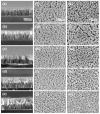Optimization of ZnO Nanorod-Based Surface Enhanced Raman Scattering Substrates for Bio-Applications
- PMID: 30884889
- PMCID: PMC6474073
- DOI: 10.3390/nano9030447
Optimization of ZnO Nanorod-Based Surface Enhanced Raman Scattering Substrates for Bio-Applications
Abstract
Nanorods based on ZnO for surface enhanced Raman spectroscopy are promising for the non-invasive and rapid detection of biomarkers and diagnosis of disease. However, optimization of nanorod and coating parameters is essential to their practical application. With the goal of establishing a baseline for early detection in biological applications, gold-coated ZnO nanorods were grown and coated to form porous structures. Prior to gold deposition, the grown nanorods were 30⁻50 nm in diameter and 500⁻600 nm in length. Gold coatings were grown on the nanorod structure to a series of thicknesses between 100 and 300 nm. A gold coating of 200 nm was found to optimize the Rhodamine B model analyte signal, while performance for rat urine depended on the biomarkers to be detected. These results establish design guidelines for future use of Au-ZnO nanorods in the study and early diagnosis of inflammatory diseases.
Keywords: Au coated SERS; ZnO nanorods; bladder disease detection; gold coated thickness; surface enhancement Raman spectroscopy (SERS).
Conflict of interest statement
The authors declare no conflict of interest.
Figures




Similar articles
-
Multi-Effect Enhanced Raman Scattering Based on Au/ZnO Nanorods Structures.Nanomaterials (Basel). 2022 Oct 27;12(21):3785. doi: 10.3390/nano12213785. Nanomaterials (Basel). 2022. PMID: 36364559 Free PMC article.
-
Diagnosis in a Preclinical Model of Bladder Pain Syndrome Using a Au/ZnO Nanorod-based SERS Substrate.Nanomaterials (Basel). 2019 Feb 7;9(2):224. doi: 10.3390/nano9020224. Nanomaterials (Basel). 2019. PMID: 30736472 Free PMC article.
-
Enhancement of local surface plasmon resonance (LSPR) effect by biocompatible metal clustering based on ZnO nanorods in Raman measurements.Spectrochim Acta A Mol Biomol Spectrosc. 2018 Nov 5;204:203-208. doi: 10.1016/j.saa.2018.06.045. Epub 2018 Jun 20. Spectrochim Acta A Mol Biomol Spectrosc. 2018. PMID: 29935391
-
SERS Effect on Spin-Coated Seeding of Tilted Au-ZnO Nanorods for Low-Cost Diagnosis.Materials (Basel). 2020 Nov 24;13(23):5321. doi: 10.3390/ma13235321. Materials (Basel). 2020. PMID: 33255438 Free PMC article.
-
Substrate Flexibility and Metal Deposition Method Effects on Piezoelectric-Enhanced SERS in Metal-ZnO Nanorod Nanocomposites.Materials (Basel). 2025 Jul 13;18(14):3299. doi: 10.3390/ma18143299. Materials (Basel). 2025. PMID: 40731510 Free PMC article.
Cited by
-
Multi-Effect Enhanced Raman Scattering Based on Au/ZnO Nanorods Structures.Nanomaterials (Basel). 2022 Oct 27;12(21):3785. doi: 10.3390/nano12213785. Nanomaterials (Basel). 2022. PMID: 36364559 Free PMC article.
-
Post-Transplant Liver Monitoring Utilizing Integrated Surface-Enhanced Raman and AI in Hepatic Ischemia-Reperfusion Injury Animal Model.Int J Nanomedicine. 2025 May 27;20:6743-6755. doi: 10.2147/IJN.S497900. eCollection 2025. Int J Nanomedicine. 2025. PMID: 40452789 Free PMC article.
-
Polycaprolactone-Based, Porous CaCO3 and Ag Nanoparticle Modified Scaffolds as a SERS Platform With Molecule-Specific Adsorption.Front Chem. 2020 Jan 10;7:888. doi: 10.3389/fchem.2019.00888. eCollection 2019. Front Chem. 2020. PMID: 31998685 Free PMC article.
-
Selective Detection of Nano-Sized Diagnostic Markers Using Au-ZnO Nanorod-Based Surface-Enhanced Raman Spectroscopy (SERS) in Ureteral Obstruction Models.Int J Nanomedicine. 2020 Oct 22;15:8121-8130. doi: 10.2147/IJN.S272500. eCollection 2020. Int J Nanomedicine. 2020. PMID: 33122904 Free PMC article.
-
Revealing the Hemispherical Shielding Effect of SiO2@Ag Composite Nanospheres to Improve the Surface Enhanced Raman Scattering Performance.Nanomaterials (Basel). 2021 Aug 27;11(9):2209. doi: 10.3390/nano11092209. Nanomaterials (Basel). 2021. PMID: 34578526 Free PMC article.
References
-
- Raman C.V., Krishnan K.S. A new type of secondary radiation. Nature. 1928;121:501–502. doi: 10.1038/121501c0. - DOI
-
- Liao P.F., Bergman J.G., Chemla D.S., Wokaun A., Melngailis J., Hawryluk A.M., Economou N.P. Surface-enhanced raman scattering from microlithographic silver particle surfaces. Chem. Phys. Lett. 1981;82:355–359. doi: 10.1016/0009-2614(81)85172-X. - DOI
Grants and funding
LinkOut - more resources
Full Text Sources
Miscellaneous

